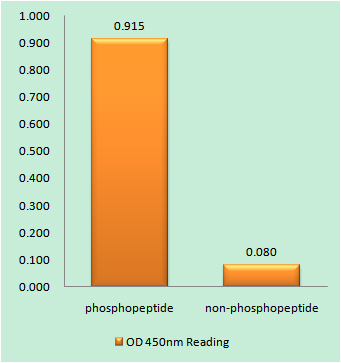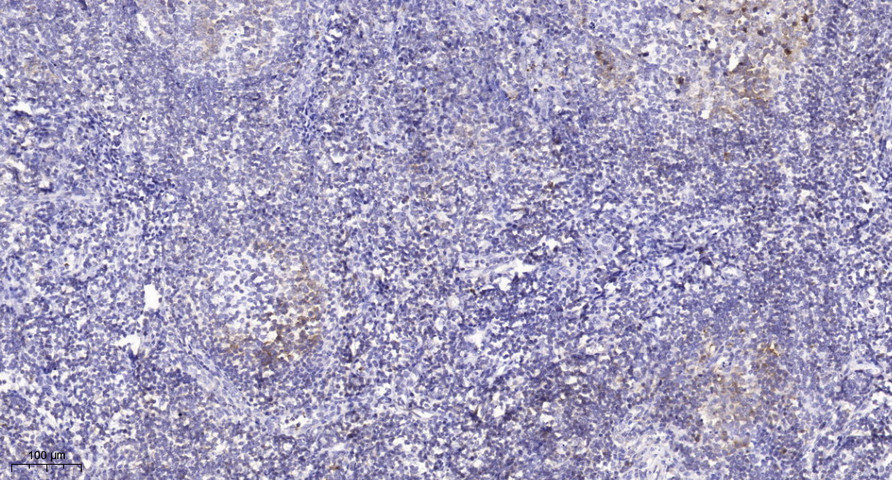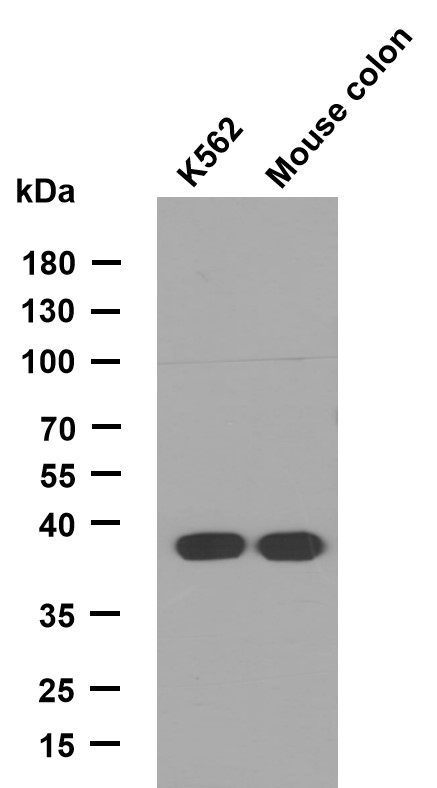CD31 (phospho Tyr713) Polyclonal Antibody
- Catalog No.:YP0530
- Applications:WB;IHC;IF;ELISA
- Reactivity:Human;Mouse
- Target:
- CD31
- Fields:
- >>Cell adhesion molecules;>>Leukocyte transendothelial migration;>>Malaria;>>Fluid shear stress and atherosclerosis
- Gene Name:
- PECAM1
- Protein Name:
- Platelet endothelial cell adhesion molecule
- Human Gene Id:
- 5175
- Human Swiss Prot No:
- P16284
- Mouse Gene Id:
- 18613
- Mouse Swiss Prot No:
- Q08481
- Immunogen:
- The antiserum was produced against synthesized peptide derived from human PECAM-1 around the phosphorylation site of Tyr713. AA range:686-735
- Specificity:
- Phospho-CD31 (Y713) Polyclonal Antibody detects endogenous levels of CD31 protein only when phosphorylated at Y713.
- Formulation:
- Liquid in PBS containing 50% glycerol, 0.5% BSA and 0.02% sodium azide.
- Source:
- Polyclonal, Rabbit,IgG
- Dilution:
- WB 1:500 - 1:2000. IHC 1:100 - 1:300. IF 1:200 - 1:1000. ELISA: 1:20000. Not yet tested in other applications.
- Purification:
- The antibody was affinity-purified from rabbit antiserum by affinity-chromatography using epitope-specific immunogen.
- Concentration:
- 1 mg/ml
- Storage Stability:
- -15°C to -25°C/1 year(Do not lower than -25°C)
- Other Name:
- PECAM1;Platelet endothelial cell adhesion molecule;PECAM-1;EndoCAM;GPIIA';PECA1;CD antigen CD31
- Observed Band(KD):
- 150kD
- Background:
- The protein encoded by this gene is found on the surface of platelets, monocytes, neutrophils, and some types of T-cells, and makes up a large portion of endothelial cell intercellular junctions. The encoded protein is a member of the immunoglobulin superfamily and is likely involved in leukocyte migration, angiogenesis, and integrin activation. [provided by RefSeq, May 2010],
- Function:
- function:This protein is a cell adhesion molecule expressed on platelets and at endothelial cell intercellular junctions.,online information:CD31 entry,online information:PECAM-1,online information:The Singapore human mutation and polymorphism database,PTM:Phosphorylated on Ser and Tyr residues after cellular activation.,similarity:Contains 6 Ig-like C2-type (immunoglobulin-like) domains.,tissue specificity:Long isoform predominates all tissues examined, isoform Delta12 was detected only in trachea and isoform Delta14-15 only in lung, isoform Delta14 was detected in all tissues examined with the strongest expression in heart.,
- Subcellular Location:
- Cell membrane ; Single-pass type I membrane protein . Cell surface expression on neutrophils is down-regulated upon fMLP or CXCL8/IL8-mediated stimulation. .; [Isoform Long]: Cell membrane ; Single-pass type I membrane protein . Membrane raft . Cell junction . Localizes to the lateral border recycling compartment (LBRC) and recycles from the LBRC to the junction in resting endothelial cells. .; [Isoform Delta15]: Cell junction . Localizes to the lateral border recycling compartment (LBRC) and recycles from the LBRC to the junction in resting endothelial cells.
- Expression:
- Expressed on platelets and leukocytes and is primarily concentrated at the borders between endothelial cells (PubMed:18388311, PubMed:21464369). Expressed in human umbilical vein endothelial cells (HUVECs) (at protein level) (PubMed:19342684, PubMed:17580308). Expressed on neutrophils (at protein level) (PubMed:17580308). Isoform Long predominates in all tissues examined (PubMed:12433657). Isoform Delta12 is detected only in trachea (PubMed:12433657). Isoform Delta14-15 is only detected in lung (PubMed:12433657). Isoform Delta14 is detected in all tissues examined with the strongest expression in heart (PubMed:12433657). Isoform Delta15 is expressed in brain, testis, ovary, cell surface of platelets, human umbilical vein endothelial cells (HUVECs), Jurkat T-cell leukemia, human erythroleuk
- June 19-2018
- WESTERN IMMUNOBLOTTING PROTOCOL
- June 19-2018
- IMMUNOHISTOCHEMISTRY-PARAFFIN PROTOCOL
- June 19-2018
- IMMUNOFLUORESCENCE PROTOCOL
- September 08-2020
- FLOW-CYTOMEYRT-PROTOCOL
- May 20-2022
- Cell-Based ELISA│解您多样本WB检测之困扰
- July 13-2018
- CELL-BASED-ELISA-PROTOCOL-FOR-ACETYL-PROTEIN
- July 13-2018
- CELL-BASED-ELISA-PROTOCOL-FOR-PHOSPHO-PROTEIN
- July 13-2018
- Antibody-FAQs
- Products Images

- Enzyme-Linked Immunosorbent Assay (Phospho-ELISA) for Immunogen Phosphopeptide (Phospho-left) and Non-Phosphopeptide (Phospho-right), using PECAM-1 (Phospho-Tyr713) Antibody

- Immunofluorescence analysis of HeLa cells, using PECAM-1 (Phospho-Tyr713) Antibody. The picture on the right is blocked with the phospho peptide.

- Western blot analysis of lysates from HepG2 cells, using PECAM-1 (Phospho-Tyr713) Antibody. The lane on the right is blocked with the phospho peptide.

- Immunohistochemical analysis of paraffin-embedded human tonsil. 1, Tris-EDTA,pH9.0 was used for antigen retrieval. 2 Antibody was diluted at 1:200(4° overnight.3,Secondary antibody was diluted at 1:200(room temperature, 45min).



